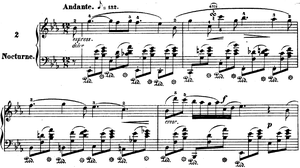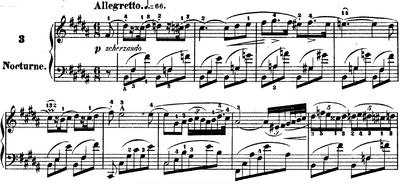- Nocturnes, Op. 9 (Chopin)
-
The Nocturnes, Op. 9 are a set of three nocturnes written by Frédéric Chopin between 1830 and 1832 and dedicated to Madame Camille Pleyel. The work was published in 1833.[1]
Contents
Nocturne in B-flat minor, Op. 9, No. 1
This nocturne has a rhythmic freedom that came to characterise Chopin’s later work. The left hand has an unbroken sequence of eighth notes in simple arpeggios throughout the entire piece, while the right hand moves with freedom in patterns of eleven, twenty, and twenty-two notes.
The opening section moves into a contrasting middle section, which flows back to the opening material in a transitional passage where the melody floats above seventeen consecutive bars of D-flat major chords. The reprise of the first section grows out of this and the nocturne concludes peacefully with a Picardy third.
Nocturne in E-flat major, Op. 9, No. 2
Chopin composed his popular Nocturne in E-flat major, Op. 9, No. 2 when he was about twenty. Like much of Chopin's music, this nocturne is tinged with melancholy.
This popular nocturne is in rounded binary form (A, A, B, A, B, A) with coda, C. The A and B sections become increasingly ornamented with each recurrence. The penultimate bar utilizes considerable rhythmic freedom, indicated by the instruction, senza tempo (without tempo). Nocturne in E-flat Major opens with a legato melody, mostly played piano, containing graceful upward leaps which becomes increasingly wide as the line unfolds. This melody is heard again three times during the piece. With each repetition, it is varied by ever more elaborate decorative tones and trills. The nocturne also includes a subordinate melody, which is played with rubato.
A sonorous foundation for the melodic line is provided by the widely spaced notes in the accompaniment, connected by the damper pedal. The waltz like accompaniment gently emphasizes the 12/8 meter, 12 beats to the measure subdivided into four groups of 3 beats each.
The nocturne is reflective in mood until it suddenly becomes passionate near the end. The new concluding melody begins softly but then ascends to a high register and is played forcefully in octaves, eventually reaching the loudest part of the piece, marked fortissimo. Tension increases dramatically as the crescendo brightly moves up to the long trill. After a brilliant trill-like passage, the excitement subsides; the nocturne ends calmly.
Analysis
- John Rink "Structural momentum and closure in Chopins Nocturne Op 9 No 2" in Schenker Studies 2 (ed. Carl Schachter, Hedi Siegel) pp102-127 Cambridge University Press, 2006 ISBN 0521028329, 9780521028325.
- Jean-Jacques Eigeldinger "Nocturne op. 9/2, E flat major" in Chopin: pianist and teacher as seen by his pupils (ed. Jean-Jacques Eigeldinger, Roy Howat) pp77-79 Cambridge University Press, 1989 ISBN 0521367093, 9780521367097.
- Eleanor Bailie "Nocturne No. 2 in E flat major" in Chopin: a graded practical guide (Eleanor Bailie, Issue 3 of The pianist's repertoire) pp303-306 Kahn & Averill, 1998 ISBN 1871082676, 9781871082678.
In film
- Exodus (1960) Nurse Katherine "Kitty" Fremont (Eva Marie Saint) has a discussion with Gen. Sutherland (Ralph Richardson) about the fate of Jewish internees in Cyprus with a background drone of Nocturne Op. 9, No. 2.
- 127 Hours (2010)[2] The scene begins some years earlier in family home with Aron's younger sister rehearsing Nocturnes, Op.9, No. 2. After several days of being pinned by a boulder, Aron Ralston (James Franco), dehydrated, delusional, and believing he is going to die, reminisces his past to the bliss of Nocturne.
- Waking Life (2001) Nocturne is played in the background of scene in the bar during various interviews (approx. 39 minutes into film)
- Rock n Rolla (2008) The nocturne is playing in the background for the scene when Gerard Butler gives the money to Thandi Newton and describes fighting off the Russian grunts.
In popular music
Muse's "+Collateral Damage" is based on Nocturne in E-flat Major, using it as an additional end piano sonata to the song "United States of Eurasia". The piece was accompanied by sounds of children laughing and jet fighters.[3]
Nocturne in B major, Op. 9, No. 3
It is in the ternary form A-B-A. The first section is set to allegretto. The second contrasting section, Agitato in B minor, is a very dramatic one with a combined melody & counter-melody in the right hand and continuous 8th note arpeggios in the left, which requires an amount of virtuosity. The piece is full of coloratura ornaments, and ends with a wide chord in the left hand accompanied with right hand triplets in a high octave to lead to a legatissimo smorzando adagio (senza tempo).[further explanation needed]
External links
- Hear the performance of the Op. 9 No. 2 Nocturne with original cadenzas at The Chopin Project
- Nocturnes Op. 9: Free scores at the International Music Score Library Project.
- Free sheet music of the Nocturnes, on Cantorion.org
- The Mutopia project has information about the composition Nocturnes, Op. 9 (Chopin).
References
- ^ Nocturnes Op. 9 at Allmusic
- ^ "127 Hours Original Motion Picture Soundtrack". soundtrack-movie.com. October 29, 2010. http://soundtrack-movie.com/127-hours/. Retrieved 2011-06-06.
- ^ David Raposa (August 3, 2009). "Muse - "United States of Eurasia / Collateral Damage"". Pitchfork. http://pitchfork.com/reviews/tracks/11417-united-states-of-eurasia-collateral-damage/. Retrieved 2011-07-14.
In TV
The popular anime Hetalia features this song as the "background music" in one of its episodes, although later it is revealed to be one of the minor characters playing the piano off-screen.
Nocturnes by Frédéric Chopin 3 Nocturnes, Op. 9 · 3 Nocturnes, Op. 15 · 2 Nocturnes, Op. 27 · 2 Nocturnes, Op. 32 · 2 Nocturnes, Op. 37 · 2 Nocturnes, Op. 48 · 2 Nocturnes, Op. 55 · 2 Nocturnes, Op. 62 · Nocturne in E minor, Op. posth. 72 · Nocturne in C-sharp minor, Op. posth. · Nocturne in C minor, Op. posth.
Chopin nocturnes
List of compositions by Frédéric Chopin by musical form
List of compositions by Frédéric Chopin by opus numberCategories:- Nocturnes by Frédéric Chopin
- 1832 compositions
Wikimedia Foundation. 2010.





